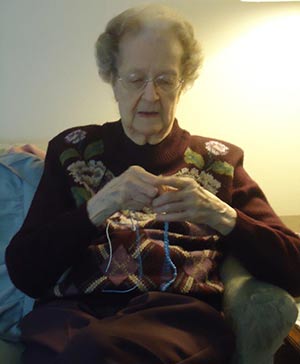Elizabeth Zablocki remembers making her first cord rosary.
 Elizabeth Zablocki makes a cord rosary in her Milwaukee home. Since 1958, Zablocki has made more than 99,825 rosaries for the International Rosary Crusade. (Catholic Herald photo by Brian T. Olszewski)It was 1958. Felician Sr. Mary Imeldine Litoborski, head dietician at Milwaukee’s St. Francis Hospital, had invited women from neighboring parishes, i.e., St. Helen, St. Gerard, St. Alexander, to come to a room near the dietary area to learn how to make cord rosaries.
Elizabeth Zablocki makes a cord rosary in her Milwaukee home. Since 1958, Zablocki has made more than 99,825 rosaries for the International Rosary Crusade. (Catholic Herald photo by Brian T. Olszewski)It was 1958. Felician Sr. Mary Imeldine Litoborski, head dietician at Milwaukee’s St. Francis Hospital, had invited women from neighboring parishes, i.e., St. Helen, St. Gerard, St. Alexander, to come to a room near the dietary area to learn how to make cord rosaries.
“Sister gave you one piece of cord,” Zablocki recalled, explaining the nun would take it apart and have the rosary-maker-in-training start over if it wasn’t done correctly. “It took me three months to make my first rosary.”
Thanks to help from her sister-in-law, Ann Zablocki, Zablocki “got it,” and has been making cord rosaries ever since – 99,825 of them. She completed two prior to the start of her interview with the Catholic Herald the morning of Oct. 4, and another by the time the interview was completed. Each was made from a 10-foot long piece of blue cord.
She used to make at least 10 a day, in yellow, pink, green, purple and brown, but now, due to carpel tunnel, she does five or six daily. At 10:30 a.m., she switches to a thicker cord and makes another rosary as she prays the rosary as it is recited on the Eternal World Television Network.
“I do one bead for each Hail Mary,” Zablocki said, noting that working with the thicker cord takes a little more time.
As she makes each rosary, which she can make faster than she can say it, Zablocki prays for the intentions of those who have requested prayers.
“I have such a long prayer list,” she said of the intentions she has received. “People ask for good health, guidance
Learn to make rosariesAnyone interested in learning how to make cord rosaries may contact Felician Sr. Samuel Holowacz at (773) 463-3020, Ext. 1912. “I will teach them myself,” she told the Catholic Herald. |
– different things.”
Sr. Imeldine died in 2004, but the International Rosary Crusade she founded in Chicago in 1948 continues. More than 7 million cord rosaries have been distributed worldwide. Today, Felician Sr. Samuel Holowacz comes from Chicago to Milwaukee six times a year, weather permitting, bringing the rosary makers cords and picking up what they have made.
Sr. Samuel is completing her third year as director of the Rosary Crusaders. She became involved with the group 10 years ago when she was still teaching at the St. Joseph Academy, located in the former St. Gerard Church and School building on 16th Street and Oklahoma Avenue. Those who can, still attend the meetings there.
At 90, Zablocki is no longer able to attend the meetings. Sr. Samuel delivers cords to her house and picks up the rosaries.
“She is such a sweet lady – a dedicated woman,” the nun said. “I told her, ‘Mary still needs you to make rosaries.’”
Sr. Samuel said she works with “about nine or 10” rosary makers. When Zablocki attended meetings at St. Francis Hospital in the late ‘50s and early ‘60s, 200 would gather in a seventh-floor meeting space.
“It’s not like it used to be,” she said.
While the number of rosary makers has dwindled, Zablocki still sees the rosary being prayed.
“When we go to church, I see people praying the rosary before Mass,” she said of the 4 p.m. Saturday Mass she regularly attends at the St. Alexander site of St. John Paul II Parish.
When she completes the cording, Zablocki leaves about six inches of it unknotted. Sisters at the Felician motherhouse in Chicago add the plastic crucifix and make the knot representing the first Our Father.
She noted that a former member of the local Rosary Crusaders group, Adeline Leifert, used to put the crucifixes on the crosses.
“She did 2 million of them,” Zablocki recalled.
When her hands get tired or she needs a change of pace, Zablocki will knit or read, but those are merely respites from her primary daily activity. Even when she has been hospitalized, she’s plied with an ample supply of cords.
“I’ve gotten so used to it that if I’m not doing it, I feel as though there’s something wrong,” she said of her daily task.
Brian T. Olszewski
